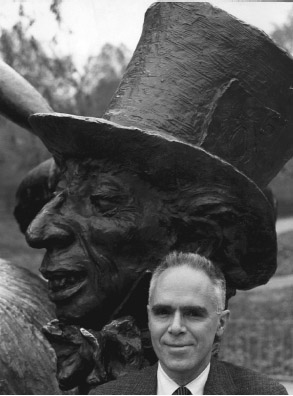 I don't know that I would have cared that much for the books of Lewis Carrol if it hadn't been for Martin Gardner. I certainly never would have discovered The Hunting of the Snark back in fifth grade, and I don't know that I would have enjoyed lateral thinking if I hadn't discovered Perplexing Puzzles and Tantalizing Teasers around the same time. As an adult, an educator, seeking sources for presenting logic problems and puzzles to students Gardner's Aha! books reminded me not only of those earlier books but that he had been a much larger influence on my reading then I realized.
I don't know that I would have cared that much for the books of Lewis Carrol if it hadn't been for Martin Gardner. I certainly never would have discovered The Hunting of the Snark back in fifth grade, and I don't know that I would have enjoyed lateral thinking if I hadn't discovered Perplexing Puzzles and Tantalizing Teasers around the same time. As an adult, an educator, seeking sources for presenting logic problems and puzzles to students Gardner's Aha! books reminded me not only of those earlier books but that he had been a much larger influence on my reading then I realized. The summer of 1972 my family moved to another part of town, to a new neighborhood. In those odd, alienated days of late June I remember exploring my new neighborhood and discovering the local branch of our town library. It was carved into the stage left wing of my new school's cafetorium, a room perhaps ten feet wide and forty feet long. Seeing that our family of six had just moved from a two-bedroom apartment to a spacious three-bedroom house the smallness didn't seem unusual or limiting to me; cramped living arrangements happened in the world, libraries included. The library was an open-armed sanctuary with a choice selection of books for a lonely 11 year old boy. That library and its books shaped a lot of who I am as a person and a reader.
I was probably looking for books I already knew – Pick a Peck of Puzzles by Arnold Roth seems likeliest – when I stumbled onto Martin Gardner. I remember Perplexing Puzzles looking very approachable, with clear language and Laszlo Kubinyi's pen and ink illustrations, even though I often couldn't solve the riddles or puzzles. Unlike many of the other similar books intended for children the puzzles didn't talk down to me as a reader or go for short term entertainment; the problems invited contemplation even after I had given up and gone in search of the answers in the back of the book.
 When I went in search of more books by Gardner I was surprised to be led to Alice in Wonderland, exhaustively annotated by Gardner and full of crazy details outlining all of Carrol's logic and whimsy. I confess, I might not have actually read Alice before then, having probably assumed I knew all I needed to know from the Disney movie adaptation. I do know that I read and grew a deeper appreciation for for the possibilities of nonsense even when it wasn't thick with hidden meaning. The invention of words, Carrol's definition of portmanteau words, the rhythm of the language... I can't say I would have picked that up without Gardner and might not have continued my friendship with books and libraries if I wasn't constantly in search of the type of surprise that came with discovering books like Gardner's.
When I went in search of more books by Gardner I was surprised to be led to Alice in Wonderland, exhaustively annotated by Gardner and full of crazy details outlining all of Carrol's logic and whimsy. I confess, I might not have actually read Alice before then, having probably assumed I knew all I needed to know from the Disney movie adaptation. I do know that I read and grew a deeper appreciation for for the possibilities of nonsense even when it wasn't thick with hidden meaning. The invention of words, Carrol's definition of portmanteau words, the rhythm of the language... I can't say I would have picked that up without Gardner and might not have continued my friendship with books and libraries if I wasn't constantly in search of the type of surprise that came with discovering books like Gardner's. Edward Lear wasn't far behind, and books of codes and ciphers, Ray Bradbury and Vonnegut closely after that. Although it sometimes seems like very distinct, wildly disparate times in my reading timeline the through-line from Dahl's Charlie and the Chocolate Factory to Vonnegut's Welcome to the Monkey House is a scant two years. And in between I don't know how many times I went back to Gardner to help pull at the taffy of my brain and expand it further into shape for lateral thinking.
I don't know that the current generation of emerging adolescent readers have anyone doing for them what Gardner did for me back then, but at least his books are still in print and widely available just in case.

1 comment:
Martin Gardner gave a long interview to The Two-Year College Math Journal in 1979. It was drastically cut to fit into the magazine's pages. I dredged up the raw transcript and have posted it for the benefit of Martin's fans, who might like to read his responses and reminiscences.
Martin Gardner Interview
Post a Comment